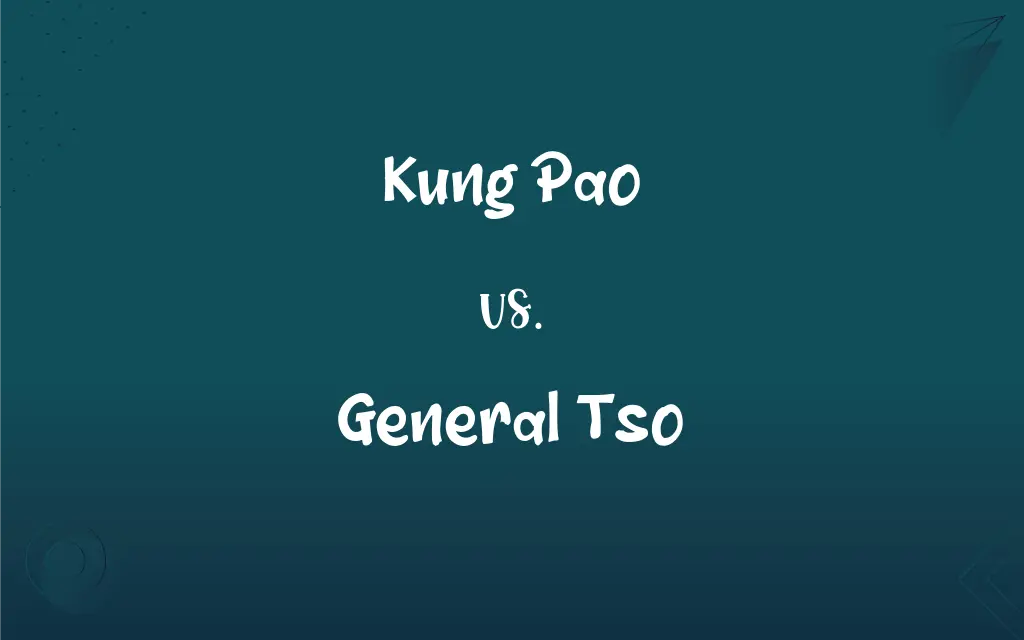Kung Pao vs. General Tso: What's the Difference?
By Harlon Moss & Janet White || Published on March 11, 2024
Kung Pao Chicken is a Sichuan dish featuring a spicy, slightly sweet sauce with peanuts, while General Tso's Chicken is a sweeter, deep-fried dish with a heavier sauce, often found in American-Chinese cuisine.

Key Differences
Kung Pao Chicken originates from the Sichuan province of China, known for its bold flavors, including spicy chilis and Sichuan peppercorns, which give it a distinctive numbing sensation. It typically includes diced chicken, peanuts, vegetables, and chili peppers. General Tso's Chicken, on the other hand, is a creation of American-Chinese cuisine, characterized by its sweet and spicy sauce, deep-fried chicken pieces, and absence of nuts. It's often garnished with green onions and served with broccoli.
Kung Pao Chicken emphasizes the balance between spicy, sour, sweet, and salty flavors with a light sauce, General Tso's Chicken leans towards a sweeter profile with a thicker, glossier sauce. The use of peanuts in Kung Pao Chicken adds a crunchy texture and nutty flavor, which is absent in General Tso's, which prioritizes a crispy texture from the fried chicken coating.
In terms of spiciness, Kung Pao Chicken generally offers a more pronounced heat due to the Sichuan peppercorns and dried chilis, appealing to those who favor spicy foods. General Tso's Chicken, while also spicy, often has its heat tempered by the sweetness of the sauce, making it more palatable to those who prefer mild to moderate spiciness.
Culturally, Kung Pao Chicken holds a place in authentic Sichuan cuisine with a history tied to the Qing Dynasty, embodying traditional Chinese cooking techniques and flavors. General Tso's Chicken, though named after a Qing Dynasty general, is more of a culinary adaptation for American tastes, reflecting the evolution of Chinese cuisine in the United States.
Both dishes showcase the diversity within Chinese cuisine and its adaptations abroad, each serving different taste preferences and culinary traditions. Whether one prefers the authentic spiciness of Kung Pao or the sweet, bold flavors of General Tso's Chicken often depends on individual taste and tolerance for spice.
ADVERTISEMENT
Comparison Chart
Origin
Sichuan, China
American-Chinese Cuisine
Key Ingredients
Diced chicken, peanuts, vegetables, Sichuan peppercorns
Deep-fried chicken, sweet and spicy sauce, sometimes served with broccoli
Texture
Crunchy (from peanuts)
Crispy (from fried chicken coating)
Sauce
Lighter, balances spicy, sour, sweet, and salty flavors
Thicker, sweeter, and glossier
Spiciness
More pronounced heat from Sichuan peppercorns and chilis
Mild to moderate, tempered by the sweetness of the sauce
ADVERTISEMENT
Kung Pao and General Tso Definitions
Kung Pao
Served with a relatively light sauce.
The sauce in Kung Pao Chicken coats the ingredients lightly, enhancing their flavors.
General Tso
Characterized by its thick, glossy sauce.
The sauce of General Tso's Chicken is rich and sweet, with a touch of heat.
Kung Pao
A spicy, nutty Sichuan dish with diced chicken and peanuts.
Kung Pao Chicken’s unique taste comes from the Sichuan peppercorns.
General Tso
Adapted for American tastes, less spicy than traditional dishes.
General Tso's Chicken caters to those who prefer a sweeter, less spicy meal.
Kung Pao
Known for its balance of flavor profiles.
The vinegar in Kung Pao Chicken adds a subtle sourness to its spicy profile.
General Tso
Lacks the nutty texture present in Kung Pao Chicken.
Unlike Kung Pao, General Tso's focuses on the interplay of sweet and spicy without nuts.
Kung Pao
Traditionally includes Sichuan peppercorns for numbing spiciness.
The numbing effect of Kung Pao Chicken is a hallmark of Sichuan cuisine.
General Tso
Often served with broccoli and garnished with green onions.
Broccoli in General Tso's Chicken provides a crisp contrast to the soft chicken.
Kung Pao
Often contains vegetables like bell peppers and zucchini.
Vegetables in Kung Pao Chicken add freshness and texture to the dish.
General Tso
A sweet and spicy, deep-fried chicken dish.
General Tso's Chicken is popular in American-Chinese restaurants for its bold flavor.
FAQs
Is General Tso's Chicken authentic Chinese food?
General Tso's Chicken is considered American-Chinese cuisine, reflecting adaptation rather than traditional Chinese cooking.
Can I find Kung Pao Chicken in China?
Yes, Kung Pao Chicken is a traditional Sichuan dish widely available in China.
Are peanuts a common ingredient in General Tso's Chicken?
No, peanuts are characteristic of Kung Pao Chicken and are not typically found in General Tso's Chicken.
What's the main difference between Kung Pao and General Tso's chicken?
Kung Pao is a spicy, nutty dish from Sichuan cuisine with a lighter sauce, whereas General Tso's is a sweeter, deep-fried dish with a thick sauce, tailored for American tastes.
Can I make these dishes less spicy?
Yes, adjusting the amount of chilis or peppercorns in Kung Pao or the spice level in General Tso's sauce can tailor the heat to your preference.
What makes Kung Pao Chicken authentic?
Its use of traditional Sichuan ingredients like Sichuan peppercorns and its balance of spicy, sour, sweet, and salty flavors make it authentic.
Is General Tso's Chicken named after a real general?
Yes, it's named after General Tso Tsung-t'ang, though the dish does not originate from his native Hunan cuisine.
Which dish is spicier, Kung Pao or General Tso's Chicken?
Kung Pao Chicken is typically spicier due to the use of Sichuan peppercorns and dried chilis.
Can Kung Pao Chicken be made vegetarian?
Yes, by substituting chicken with tofu or a variety of vegetables, you can create a vegetarian version that still captures the essence of the dish.
Why is General Tso's Chicken sweet?
The sweetness caters to American palates, distinguishing it from the more authentically spicy Chinese dishes.
What side dishes pair well with General Tso's Chicken?
Steamed rice, stir-fried vegetables, or a light salad complement the flavors and textures of General Tso's Chicken well.
Which dish is healthier, Kung Pao or General Tso's Chicken?
Kung Pao Chicken might be considered healthier due to less sugar and the absence of deep frying, offering a lighter sauce and the inclusion of vegetables and nuts.
What is the significance of the peanuts in Kung Pao Chicken?
Peanuts add a crunchy texture and nutty flavor, balancing the spiciness and adding depth to the dish.
Can I make General Tso's Chicken less sweet?
Yes, adjusting the sugar content in the sauce allows you to reduce sweetness according to your preference.
Why is General Tso's Chicken often served with broccoli?
Broccoli provides a refreshing, slightly bitter contrast to the sweet and spicy chicken, adding nutritional value and color.
Is there a gluten-free version of Kung Pao Chicken?
Gluten-free Kung Pao Chicken can be made using tamari or a gluten-free soy sauce alternative and ensuring all other ingredients are gluten-free.
How do I cook General Tso's Chicken to achieve the crispy texture?
Deep-fry battered chicken pieces until golden brown, then toss them in the sauce just before serving to maintain crispiness.
How do I balance the flavors in Kung Pao Chicken?
Carefully adjust the amounts of soy sauce, vinegar, sugar, and Sichuan peppercorns to achieve a harmonious balance between spicy, sour, sweet, and salty.
What makes General Tso's Chicken different from other American-Chinese dishes?
Its unique combination of sweetness, spiciness, and the crispy texture of the chicken sets it apart from other dishes like orange chicken or sweet and sour chicken, highlighting the creativity of American-Chinese cuisine.
What kind of vegetables are found in Kung Pao Chicken?
Commonly includes bell peppers, zucchini, and sometimes carrots, adding crunch and color to the dish.
About Author
Written by
Harlon MossHarlon is a seasoned quality moderator and accomplished content writer for Difference Wiki. An alumnus of the prestigious University of California, he earned his degree in Computer Science. Leveraging his academic background, Harlon brings a meticulous and informed perspective to his work, ensuring content accuracy and excellence.
Co-written by
Janet WhiteJanet White has been an esteemed writer and blogger for Difference Wiki. Holding a Master's degree in Science and Medical Journalism from the prestigious Boston University, she has consistently demonstrated her expertise and passion for her field. When she's not immersed in her work, Janet relishes her time exercising, delving into a good book, and cherishing moments with friends and family.































































